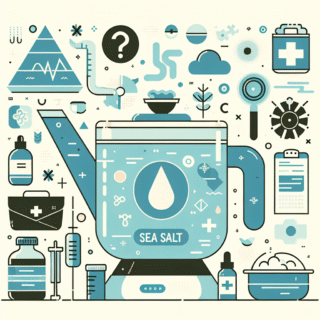
More Ear, Nose & Throat Articles
Can You Use Sea Salt in Neti Pot?

Rinsing the nose with a saline solution is a common therapy for congestion, allergies, and sinus discomfort, and many people wonder whether sea salt is an acceptable ingredient. If you’re asking whether sea salt can be used in nasal rinses, this article reviews safety, dilution, water quality, and best practices so you can decide whether a neti pot or other nasal wash approach is right for you.
Sea salt solution: safe recipe and how it differs from table salt
First, understand that “sea salt” differs from table salt mainly in trace minerals and processing; it is not inherently antimicrobial. Whether you’re searching for “can i use sea salt for nasal rinse” or “neti pot sea salt” the critical issues are proper dilution and clean water. A typical isotonic saline for nasal irrigation is about 0.9% saline — roughly 1/4 to 1/2 teaspoon of non-iodized salt per 8 ounces (240 ml) of sterile water. Many prefabricated packets note their salt is designed for nasal use, which removes guesswork.
Practical guidance: mixing, water, and choosing the right salt
People ask variations of the same question: “can you use sea salt for neti pot,” “can you use sea salt in a neti pot,” and even “can you use sea salt in neti pot.” The answer: you can use sea salt only if it is pure, free of additives (like anti-caking agents or iodine), and you mix it to the correct concentration with safe water. Never use salt labeled with additives, and never use seawater directly.
Equally important is water quality. Tap water can contain organisms that survive typical nasal environments; for safe nasal irrigation, use distilled or previously boiled and cooled water. For a general overview of nasal irrigation practices and safety, see this detailed entry on nasal irrigation: nasal irrigation (overview).
Sea salt for nasal irrigation vs. other options
Searches often mention “sea salt for nasal rinse,” “sea salt nasal irrigation,” and “sea salt nasal wash.” These are essentially the same idea: using sea salt to create a saline solution for rinsing. If you prefer packaged saline, look for packets labeled for nasal use. Many people also refer to “sea salt nose rinse” or “sea salt sinus rinse” when discussing at-home remedies for sinus pressure. Whatever label you use, the priorities are correct concentration and sterile water.
How to perform a safe neti pot rinse
- Mix 1/4 to 1/2 teaspoon of pure, additive-free salt per 8 ounces of sterile water for an isotonic solution.
- Warm the solution to body temperature; cold or hot fluid can be uncomfortable.
- Lean over a sink, tilt your head, insert the spout of the neti pot into the upper nostril, and let the solution flow through the nasal passage and out the other nostril.
- Blow gently after rinsing each side to clear remaining saline.
- Clean the neti pot thoroughly and allow it to dry between uses.
Some people search for consumer-friendly phrases like “sea salt nasal wash” or “sea salt nose rinse,” while others ask “can you use sea salt for neti pot” out of caution. Both are reasonable starting points; just follow safety guidelines.
When not to use a sea salt rinse and other caveats
If you have recent nasal surgery, severe nosebleeds, or certain chronic conditions, consult a clinician before using a neti pot. Also avoid using flavored or seasoned salts — amusingly, some searches even include unrelated terms like “skinny pop sea salt and pepper,” which serves as a reminder that not all salt products are suitable for medical use. If you experience persistent pain, new or worsening symptoms, or signs of infection after a nasal rinse, stop the rinse and seek medical advice.
Some users prefer sterile saline packets or doctor-recommended solutions to avoid confusion about measurements and salt purity. If you’re unsure which product to choose, ask your pharmacist or physician for guidance.
For related information on how sinus problems can affect other areas — for example, dental pain linked to sinusitis — see this helpful piece on sinus-related dental pain and symptoms: sinus-related dental pain explained.
- Takeaways:
- Only use pure, additive-free sea salt mixed to an appropriate concentration with sterile water.
- Boiled, cooled, or distilled water is essential; do not use untreated tap water.
- Consider pre-measured saline packets for convenience and consistent salinity.
- Stop rinsing and consult a clinician if you develop unusual symptoms.
Is store-bought sea salt safe for a neti pot?
Only if the sea salt is pure with no additives. Many gourmet salts contain anti-caking agents or flavors and are not suitable for nasal irrigation. Choose non-iodized, additive-free salt or a saline packet designed for nasal use.
How often should I do a sea salt sinus rinse?
Frequency depends on your symptoms. For routine relief of congestion or allergies, once daily can be effective; some people rinse up to twice daily during flare-ups. Follow your healthcare provider’s recommendations, and avoid overuse if it leads to nasal irritation.
Other Articles You May Find of Interest...
- The Best Salts for Your Nasal Rinse: Sea, Table, or Iodized?
- Mastering Saline Solution: Your Guide to Using a Neti Pot for Optimal Nasal Health
- Relief Strategies for a Blocked Eustachian Tube That Won’t Unblock
- Hydrogen Peroxide in Your Ear: Is It Safe and Effective?
- What Causes a Swollen Earlobe and How to Treat It?
- Is Something Stuck in Your Throat? Unpacking the Discomfort and Possible Causes
- Effective Ear Drops for Pain Relief: Your Guide to Over-the-Counter Solutions














